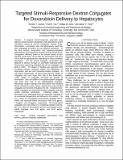| dc.description.abstract | A targeted, stimuli-responsive, polymeric drug delivery vehicle has been developed to help alleviate the severe side-effects caused by narrow therapeutic window drugs. Doxorubicin, a commonly used chemotherapeutic agent has been conjugated to dextran by two different techniques. In the first method, doxorubicin and hepatocyte-targeting galactosamine were attached to dextran through amine bonds. Conjugation efficiency based on the amount loaded of each reactant varied from 1% to 50% for doxorubicin and from 2% to 20% for galactosamine, depending on various synthesis parameters. For the second conjugate, doxorubicin was attached to dextran through an acid-labile hydrazide bond. Fluorescence quenching indicated that all our conjugates can bind to DNA. The degree of binding was improved with increasing polymer molecular weight and substitution of doxorubicin, and also with hydrazide-bonded conjugate. In cell culture experiments, we have found that the uptake of conjugates was much lower than that of free doxorubicin. Lower uptake of conjugates decreased the toxicity of doxorubicin. Also, the uptake of non-galactosylated conjugate was lower than that of the galactosylated conjugate. Microscopy studies indicated that doxorubicin was localized almost exclusively at the nucleus, whereas the amine-bonded conjugates were present throughout the cell. Targeted amine-linked conjugates and hydrazide-bonded conjugates achieved greatly improved cytotoxicity. Following uptake, the doxorubicin was dissociated from the hydrazide conjugate in an endosomal compartment and diffused to the nucleus. The LC₅₀ values of non-targeted amine-linked, targeted amine-linked, and hydrazide-linked doxorubicin were 19.81 μg/mL, 7.33 μg/mL and 4.39 μg/mL, respectively. The amine-linked conjugates were also tested on a multidrug-resistant cell line; the LC₅₀ values of doxorubicin and the non-targeted amine-linked conjugate were 8.60 μg/mL and 36.02 μg/mL, respectively. | en |
